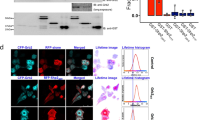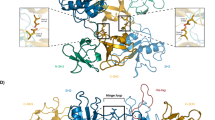Abstract
hSos1 isoform II, defined by the presence of a 15 amino acid stretch in its carboxy-terminal region, exhibits higher Grb2 affinity than hSos1 isoform I. In this study, we investigated the cause for this difference and observed that, in addition to the four currently accepted Grb2-binding motifs, a number of additional, putative SH3-minimal binding sites (SH3-MBS) could be identified. The isoform II-specific 15 amino acid stretch contained one of them. Indeed, we demonstrated by site-directed mutagenesis that these SH3-MBS were responsible for the Grb2 interaction, and we found that C-terminal fragments of the two hSos1 isoforms (lacking the four cannonical Grb2-binding motifs, but containing the SH3-minimal binding sites) were able to bind Grb2, with the isoform II fragment showing higher Grb2 affinity than the corresponding isoform I fragment. Furthermore, we provide evidence that C-terminal truncated mutants of either hSos1 isoform, containing only the SH3-minimal binding sites, were able to originate in vivo stable complexes with Grb2. Although, Grb2-binding remains higher in both full-length isoforms, compared to the C-terminal truncated mutants, these mutants were also able to activate Ras, supporting a potential role of this C-terminal region as negative modulator of Sos1 activity. These findings document the existence of a new, functional, SH3-minimal binding site located in the specific stretch of hSos1 isoform II which may be responsible for the increased Grb2 affinity of this isoform in comparison to isoform I, and for the physiological properties differences between both isoforms. Moreover, these SH3-minimal binding sites may be sufficient to attain stable and functional hSos1-Grb2 complexes.
This is a preview of subscription content, access via your institution
Access options
Subscribe to this journal
Receive 50 print issues and online access
$259.00 per year
only $5.18 per issue
Buy this article
- Purchase on Springer Link
- Instant access to full article PDF
Prices may be subject to local taxes which are calculated during checkout







Similar content being viewed by others
References
Aronheim A, Engelberg L, Al-Alawi N, Schlessinger J and Karin M. . 1994 Cell 78: 949–961.
Boguski M and McCormick F. . 1993 Nature 366: 643–654.
Boriack-Sjodin PA, Margarit SM, Bar-Sagi D and Kuriyan J. . 1998 Nature 394: 337–343.
Byrne JL, Paterson HF and Marshall CJ. . 1996 Oncogene 13: 2055–2065.
Chardin P, Camonis JH, Gale NW, van Aelst L, Schlessinger J, Wigler MH and Bar-Sagi D. . 1993 Science 260: 1338–1343.
Chardin P, Cussac D, Maignan S and Ducruix A. . 1995 FEBS Lett. 369: 47–51.
Cherniack A, Klarlund J and Czech M. . 1994 J. Biol. Chem. 269: 4717–4720.
Corbalan-Garcia S, Margarit SM, Galron D, Yang SS and Bar-Sagi D. . 1998 Mol. Cell Biol. 18: 880–886.
Corbalan-Garcia S, Yang SS, Degenhardt KR and Bar-Sagi D. . 1996 Mol. Cell Biol. 16: 5674–5682.
Cussac D, Frech M and Chardin P. . 1994 EMBO J. 13: 4011–4021.
Cussac D, Vidal M, Leprince C, Liu WQ, Cornille F, Tiraboschi G, Roques BP and Garbay C. . 1999 FASEB J. 13: 31–38.
den Hertog J, Tracy S and Hunter T. . 1994 EMBO J. 13: 3020–3032.
Douville E and Downward J. . 1997 Oncogene 15: 373–383.
Downward J. . 1994 FEBS Lett. 338: 113–117.
Egan S and Weinberg R. . 1993 Nature 365: 781–783.
Feig L. . 1994 Curr. Op. Cell Biol. 6: 204–211.
Feng S, Chen JK, Yu H, Simon JA and Schreiber SL. . 1994 Science 266: 1241–1247.
Gotoh T, Hattori S, Nakamura S, Kitayama H, Noda M, Takai Y, Kaibuchi K, Matsui H, Hatase O, Takahashi H, Kurata T and Matsuda M. . 1995 Mol. Cell. Biol. 15: 6746–6753.
Guan KL and Dixon JE. . 1991 Anal. Biochem. 192: 262–267.
Guerrero C, Fernandez-Medarde A, Rojas JM, Font de Mora J, Esteban LM and Santos E. . 1998 Oncogene 16: 613–624.
Holsinger LJ, Spencer DM, Austin DJ, Schreiber SL and Crabtree GR. . 1995 Proc. Natl. Acad. Sci. USA 92: 9810–9814.
Joneson T and Bar-Sagi D. . 1997 J. Mol. Med. 75: 587–593.
Karlovich CA, Bonfini L, McCollam L, Rogge RD, Daga A, Czech MP and Banerjee U. . 1995 Science 268: 576–579.
Kim JH, Shirouzu M, Kataoka T, Bowtell D and Yokoyama S. . 1998 Oncogene 16: 2597–2607.
Koshiba S, Kigawa T, Kim JH, Shirouzu M, Bowtell D and Yokoyama S. . 1997 J. Mol. Biol. 269: 579–591.
Li BQ, Subleski M, Fusaki N, Yamamoto T, Copeland T, Princler GL, Kung H and Kamata T. . 1996 Proc. Natl. Acad. Sci. USA 93: 1001–1005.
Li BQ, Subleski M, Shalloway D, Kung HF and Kamata T. . 1993a Proc. Natl. Acad. Sci. USA 90: 8504–8508.
Li BQ, Wang MH, Kung HF, Ronsin C, Breathnach R, Leonard EJ and Kamata T. . 1995 Biochem. Biophys. Res. Commun. 216: 110–118.
Li N, Batzer A, Daly R, Yajnik V, Skolnik E, Chardin P, Bar-Sagi D, Margolis B and Schlessinger J. . 1993b Nature 363: 85–88.
Lim WA and Richards FM. . 1994 Nat. Struct. Biol. 1: 221–225.
Marinissen MJ, Chiariello M, Pallante M and Gutkind JS. . 1999 Mol. Cell. Biol. 19: 4289–4301.
Mayer BJ and Eck MJ. . 1995 Curr. Biol. 5: 364–367.
McCollam L, Bonfini L, Karlovich CA, Conway BR, Kozma LM, Banerjee U and Czech MP. . 1995 J. Biol. Chem. 270: 15954–15957.
McCormick F. . 1993 Nature 363: 15–16.
McPherson PS, Czernik AJ, Chilcote TJ, Onofri F, Benfenati F, Greengard P, Schlessinger J and De Camilli P. . 1994 Proc. Natl. Acad. Sci. USA 91: 6486–6490.
Mendelsohn AR and Brent R. . 1994 Curr. Opin. Biotechnol. 5: 482–486.
Nimnual AS, Yatsula BA and Bar-Sagi D. . 1998 Science 279: 560–563.
Pawson T. . 1995 Nature 373: 573–580.
Pawson T and Schlessinger J. . 1993 Curr. Biol. 3: 4345–4442.
Quilliam LA, Huff SY, Rabun KM, Wei W, Park W, Broeck D and Der CJ. . 1994 Proc. Natl. Acad. Sci. USA 91: 8512–8516.
Quilliam LA, Khosravi-Far R, Huff SY and Der CJ. . 1995 Bioessays 17: 395–404.
Ren R, Mayer BJ, Cicchetti P and Baltimore D. . 1993 Science 259: 1157–1161.
Rojas JM, Coque JJR, Guerrero C, Aroca P, Font de Mora J, de la Cruz X, Lorenzi MV, Esteban LM and Santos E. . 1996 Oncogene 12: 2291–2300.
Rojas JM, Subleski M, Coque JJ, Guerrero C, Saez R, Li BQ, Lopez E, Zarich N, Aroca P, Kamata T and Santos E. . 1999 Oncogene 18: 1651–1661.
Rozakis-Adcock M, Fernley R, Wade J, Pawson T and Bowtell D. . 1993 Nature 363: 83–85.
Rozakis-Adcock M, McGlade J, Mbamalu G, Pelicci G, Daly R, Li W, Batzer A, Thomas S, Brugge J, Pelicci PG, Schlessinger J and Pawson T. . 1992 Nature 360: 689–692.
Rozakis-Adcock M, van der Geer P, Mbamalu G and Pawson T. . 1995 Oncogene 11: 1417–1426.
Schlessinger J. . 1993 Trends Biochem. Sci. 18: 273–276.
Simon JA and Schreiber SL. . 1995 Chem. Biol. 2: 53–60.
Soisson SM, Nimnual AS, Uy M, Bar-Sagi D and Kuriyan J. . 1998 Cell 95: 259–268.
Sudol M. . 1998 Oncogene 17: 1469–1474.
Taylor S and Shalloway D. . 1996 Current Biology 6: 1621–1627.
Tong X-K, Hussain NK, de Heuvel E, Kurakin A, Abi-Jaoude E, Quinn CC, Olson MF, Marais R, Baranes D, Kay BK and McPherson PS. . 2000 EMBO J. 19: 1263–1271.
Wang W, Fisher E, Jia Q, Dunn J, Porfiri E, Downward J and Egan S. . 1995 Nature Gen. 10: 294–300.
Ye ZS and Baltimore D. . 1994 Proc. Natl. Acad. Sci. USA 91: 12629–12633.
Yu H, Chen JK, Feng S, Dalgarno DC, Brauer AW and Schreiber SL. . 1994 Cell 76: 933–949.
Zohar M, Teramoto H, Katz BZ, Yamada KM and Gutkind JS. . 1998 Oncogene 17: 991–998.
Acknowledgements
We thank Drs R Brent, SJ Taylor, D Shalloway and SJ Gutkind and for providing yeast strain and DNA constructs. This work was supported by DGICYT (PM95-0053), FIS (98/1336), CAM (08.1/0003.1/99) and Ratiopharm grants to JM Rojas. N Zarich, JL Oliva and R Jorge were recipients of predoctoral fellowships from Instituto de Salud Carlos III (N Zarich and R Jorge), FIS-BEFI (JL Oliva) and AECC (R Jorge).
Author information
Authors and Affiliations
Rights and permissions
About this article
Cite this article
Zarich, N., Oliva, J., Jorge, R. et al. The isoform-specific stretch of hSos1 defines a new Grb2-binding domain. Oncogene 19, 5872–5883 (2000). https://doi.org/10.1038/sj.onc.1203955
Received:
Revised:
Accepted:
Published:
Issue Date:
DOI: https://doi.org/10.1038/sj.onc.1203955
Keywords
This article is cited by
-
The CSN3 subunit of the COP9 signalosome interacts with the HD region of Sos1 regulating stability of this GEF protein
Oncogenesis (2019)
-
PGA1-induced apoptosis involves specific activation of H-Ras and N-Ras in cellular endomembranes
Cell Death & Disease (2016)
-
Insulin restores differentiation of Ras-transformed C2C12 myoblasts by inducing NF-κB through an AKT/P70S6K/p38-MAPK pathway
Oncogene (2002)



